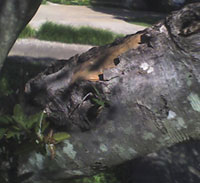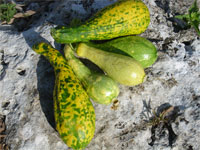Question and Answer – July 2009
We had many dozens of questions this month. I’ve limited them to those that were accompanied by photos, as well as those of the broadest reader interest. (Sadly, that rules out plant ID questions.)
Even with those cutbacks, there still are many remaining to be answered. Before I plunge into them, I have a quick request. Please let me know your city. I can’t tell it from e-mail addresses, and the accuracy of my answer may very well depend on where you’re growing the plant.
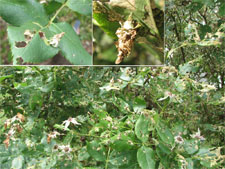
Question: Something ate the leaves on our Knockout rose. When I noticed the holes in the leaves, it was already too late. The larvae had already done their damage. Now, we have thousands of small cocoons attached to the leaves. What kind of insect did this? The attached photo shows a portion of the rose bush, with two insets showing close-ups of the cocoons. E.G., no city given.
Answer: Wow! These are bagworms – the same pests that strip our junipers, arbor vitae and cypress. You may garden another 50 years without ever seeing them on your roses again – at least to this level. Use Sevin or B.t. biological worm spray if you ever see this kind of damage starting again. Meanwhile, pull off the bags and destroy them. Trim your rose, and apply an all-nitrogen fertilizer to stimulate regrowth. The plant should be fine.
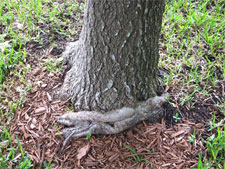
Question: The attached pictures are of a 12-year-old Shumard red oak that was planted from a container. The circular roots from the container were not cut prior to planting, and I think one of them is now surfacing above ground. Is this "girdling" root doing any damage to the tree? Can I/should I cut it off at ground level, or just leave it alone? D.F., no city given.
Answer: Definitely cut and remove it before the trunk grows around it any more. It probably wouldn’t hurt to wait until late September, once temperatures begin to moderate and the plant’s water needs lessen, but don’t let it go beyond that. Cut it where it emerges from the ground as well as where it heads back into the soil, then physically remove the short section of unwanted root.
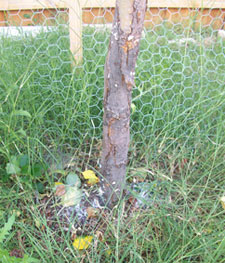
Question: My 4-year-old apple tree looks sickly! It has a white, lint-like substance around the base near the ground, and as I hope you can see from the photo, cracking bark along the bottom of the trunk. It has produced some small apples the past year, and it still has some leaves and several apple buds. Advice? M. H., Grand Prairie.
Answer: Things don’t look good for your tree. The cracking of the trunk looks like old sunscald from a prior year, and the sparse foliage that shows in your other photo indicates that the tree is really struggling. Apples are a bit of a challenge in North Texas, partly due to the very hot summers, and partly due to the cotton root rot soil-borne fungus (for which we have no control). You might try trimming the tree to reduce demands on the root system to pull in water. However, you’re probably going to end up replacing it before much more time passes.
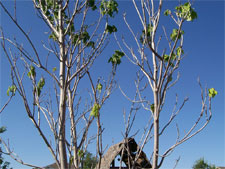
Question: I planted this maple in spring 2008. When I went on vacation last summer in June, it didn’t get watered by its caretaker (per instructions), which caused it to become greatly stressed. Its leaves turned brown, and it lost all of them by August despite my efforts to revive it. Now, it has many buds that haven’t opened, but it’s still green when I scratch it. I’m trying to keep a drip on it every few days, and I’ve added some humus and fertilizer. Any other suggestions or should I throw in the "trowel"? L.F., Denton.
Answer: My answer will be brief. Start throwing. (Great line.) Possibly, you shouldn’t take it all out on your caretaker, however. If the tree was balled-and-burlapped, the dieback could have been due to transplant shock. On the other hand, if it was from a container, all of its roots would have been intact, so watering would have helped it survive.
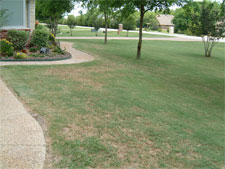
Question: This bermudagrass lawn was planted from sod three years ago. This problem began to show up several weeks ago. It started with small splotches of browned grass, but now it’s more widespread. I pulled on it, and the grass came loose easily, but I dug and couldn’t find any grubworms. I have used Sevin on it, and I’ve been watering approximately 20 minutes each day for several days. I’ve never seen this symptom. What might the cause be? M.R., Rockwall.
Answer: I really would suspect that this is fungal in origin, but the only way to know for sure would be to have a sample run through the Plant Disease Diagnostic Laboratory at Texas A&M. Your Rockwall County Extension office can give you the details. Turf experts are reporting a rapid increase in incidence of Take All Root Rot in bermudagrass, just as we’ve been seeing in St. Augustine for the past 15 years. TAMU research done by Dr. Phil Colbaugh found that adding Canadian peat moss in a 1-inch layer, then watering it into the top of the lawn actually did more good than applying fungicides. To my knowledge, I haven’t seen this fungus in bermudagrass, but this closely resembles how my St. Augustine looked three years ago before I gave it the peat moss treatment. The turnaround was sudden. You should have a sample run through the laboratory, but you could also try a bale or two of peat in the interim, to see if it helps.
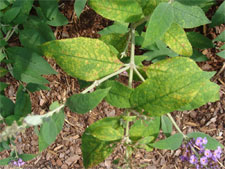
Question: My husband and I expanded our garden last fall. We worked mushroom/pine bark mulch and compost into the soil. We planted flowers and vegetables into the soil, and all have done well except for yellowing of the leaves of some. Could this be iron deficiency? K.A., Arlington.
Answer: This is not iron deficiency. That would show up as yellowed leaves with dark green veins, and it’s most prominent on the newest growth first. Before I looked at your photo, I thought I would be seeing nitrogen deficiency (overall yellowing and stunting) due to the use of too-fresh organic matter. When I enlarged your photo I could tell that this really looks like spider mite damage. They are nearly microscopic pests that infest plants on the bottoms of their leaves. Thump a suspect stem over white paper. If you see tiny, paprika-colored specks starting to move, those are the mites. Use a general-purpose insecticide that is also labeled for mites to stop them. We no longer have specific miticides for home garden use.
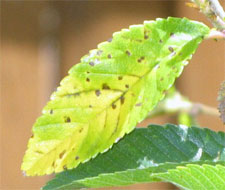
Question: Something appears to be attacking my lacebark elm. It seems to be worst on the newest growth. The older growth looks normal. Advice? No name given, McKinney.
Answer: This is an unusual occurrence. This is either fungal (due to the prolonged wet weather back in May), or it’s damage done by some type of weed killer or weed-and-feed fertilizer. The spotting on the leaves really does look like a disease might be involved, but it will probably abate with summer’s hot, dry weather. The call to action now would probably be simply to sit tight and monitor the tree. It will probably come back very well.
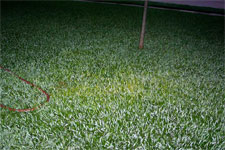
Question: This spot seems to move each year. It never dies – just turns yellow. Any thought as to what we can do with it? N.P., no city given.
Answer: It’s really hard to tell just from your photo, but due to the time of year, perhaps this is early-onset chinch bug damage. They cause St. Augustine to turn yellow, then to look as if it needs to be watered. They love hot, sunny weather, so you’ll see them in the most foreboding parts of your yard. If you get down on your hands and knees and part the grass, you’ll see the small, black insects moving about freely. General lawn insecticides will eliminate them, but be sure they’re actually there before you treat.
Question: Sunscald caused the bark on my mature weeping yaupon to split. What can I do to protect it and prevent it from happening again in the future? M.L., McKinney.
Answer: Shade is your best ally, and it looks like the holly is beginning to shade its own trunks. Sun damage isn’t common with mature specimens. Vote here would be to wait it out. The tree will probably heal itself if it’s given time.
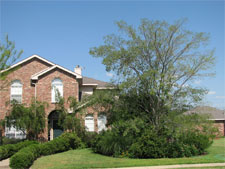
Question: We have a 9-year-old lacebark elm that has a very thin canopy. It did the same thing last summer. Any ideas what might be going on with this tree? (Photo from several years ago, as comparison to what it looks like today.) D.S., no city given.
Answer: This is where I really need to know where you live. But, considering Texas as a whole, the most probable causes would be the soil-borne fungus cotton root rot or borers. We don’t have a treatment for cotton root rot, other than to plant species that aren’t susceptible to it. If you find that it’s borers, applying a labeled insecticide monthly from late spring until mid-fall would offer some degree of protection. My guess would be the former problem, and I am sad to say that you’ll probably need to replace it within the next year or two.

Before
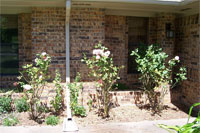
After
Question: My Tuscan Sun roses are normally vigorous growers and heavy bloomers. This year, they’re losing leaves, and their branches are dying. I have treated for black spot just as I always do. Is this because of all the rain we had late in the spring? My grandfather in Sherman is having the same trouble with his roses. E.T., Tom Bean.
Answer: This is, indeed, the result of black spot. When you have a susceptible variety (i.e., most roses), and when you have warm, humid conditions, you can expect it to be serious. Treat with a labeled fungicide weekly when conditions are ripe for the disease – generally, all spring and the first half of the fall. Keep the leaves dry when you water. Trim your plants now to reshape them before they regrow late this summer and fall. You might also consider replacing them with varieties designated as EarthKind® by Texas A&M. They are resistant or immune to the black spot fungus.
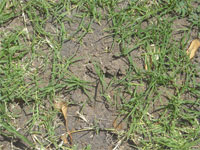
Question: My common bermudagrass lawn is in poor shape due to the shading of the trees. I’d like to convert it over to St. Augustine. How far apart should I plant the squares? Should I till up the entire yard? R.Y., Mesquite.
Answer: Definitely do NOT rototill the entire area. You can easily plant St. Augustine from plugs, and it will grow and crowd out the bermudagrass. Cut St. Augustine sod into 6×6-inch squares, and plant them on 18-inch centers in the sunny parts of your yard. Solid-sod in the shaded spaces, since even St. Augustine is slow to grow and cover when it’s in the shade.
Question: What causes the green blotches on my yellow squash? H.M., Cranfills Gap.
Answer: Well, those are ugly. This is caused by a virus, and as with human viruses, there isn’t much you can do about it. The fruit is edible, if you care to do so. Start with fresh seeds next season, and plant them into a different part of your garden.
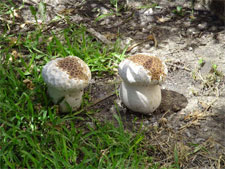
Question: My husband found one of these mushrooms growing by our oleander bush a month ago. He kicked it out of the way, but now two have grown back in its place. What kind is it, and how can we get rid of them? P.M., no city given.
Answer: A mycologist would have to identify it for you. They’re trained to deal with all manners of funguses. However, the more general answer is that all mushrooms and toadstools are saprophytic funguses that live off decaying organic matter. They’re harmless, and they’ll eventually run their course. If you want to eliminate them, remove them physically, or treat the area with dusting sulfur. Keep it out of your eyes and off desirable foliage, as it can scorch the leaves.
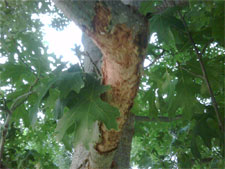
Question: What is attacking the branches of my Shumard red oak? I see no bark on the ground, and I don’t see any indication of a disease. How can I stop it? R.B., Fort Worth.
Answer: It really looks like the severe aftermath of a sapsucker attack. They’re woodpecker relatives, and they can riddle trees. The holes they drill typically are on the bottom sides of branches, as they hang while they’re pecking. They often go after one specific part of a branch, but they seldom do this much damage. Look at the rest of your tree to see if you find any rows of holes that would validate this guess. Beyond that, squirrels are about the only other animals likely to do this kind of work. However, with squirrels, you usually see shards of the bark on the ground beneath the trees.
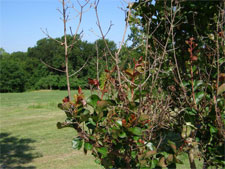
Question: My crape myrtles are all dead on the tips of their branches. What did I do, or not do, and how should I fix this? Do I need to trim the dead tips off? M.T., Grayson County.
Answer: This is probably damage from winter cold. Gardeners around the DFW Metroplex saw this kind of damage three years ago, and there has been a lesser amount of it this spring and summer. Grayson County is a great place to grow crape myrtles, but some varieties (Tuscarora, Muskogee, Sioux, Natchez and Country Red) have proven to be more vulnerable to cold than others. Trim off the dead growth, and prune as much of the new growth as you must to reshape your plants. Keep the plants vigorous the balance of this season. That will lessen the likelihood of damage next winter.
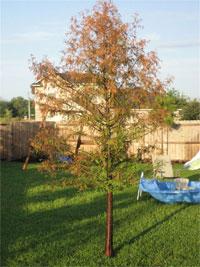
Question: We recently planted a bald cypress tree in our back yard. This is the third tree (one oak and one bald cypress) that we’ve had in this part of our yard, but now it’s struggling, too. I have others in other parts of my yard, and they’re doing fine, but a new one planted Memorial Day weekend now looks unhealthy. Can you offer suggestions? C., no city given.
Answer: This tree has almost assuredly gotten too dry at least once since it was planted, probably fairly recently. They use a great deal of water, and they’re quite vulnerable to drought. I reread your note, and it looks like this tree has been in your landscape for only a few months. The grass has certainly recovered well. Hopefully, the tree can rebound as you keep it moist at all times. You might also want to switch to other types of trees such as oaks, cedar elms, pecans or Chinese pistachios. Depending on how far west you are in Texas, they’re likely to do better for you in the long run.


